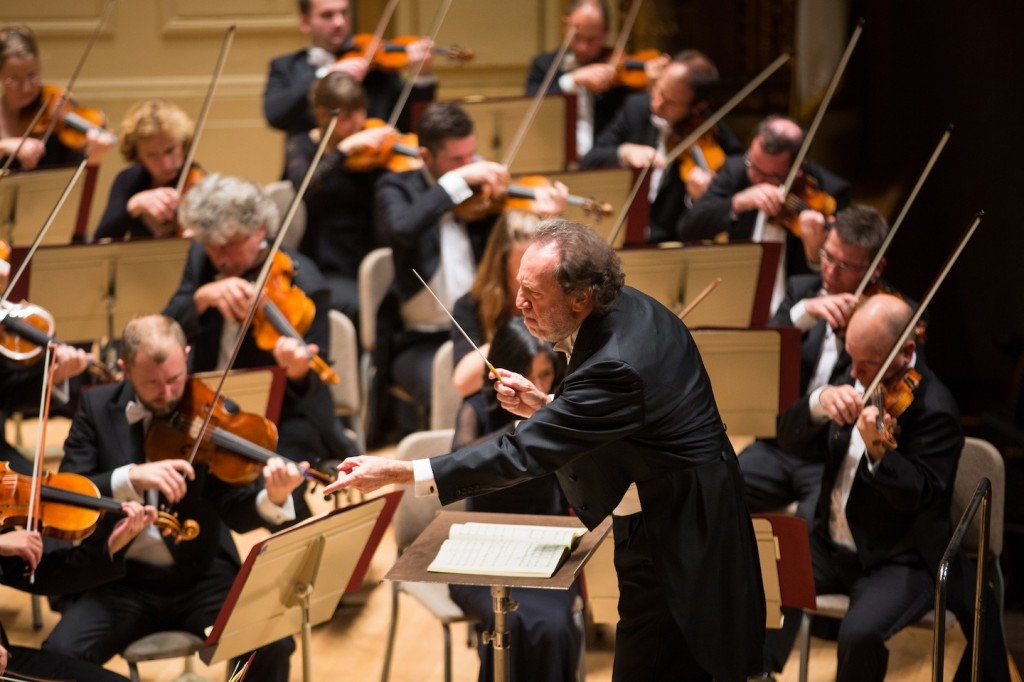Chailly and storied Leipzig orchestra bring Old World richness to Mendelssohn

Riccardo Chailly conducted the Leipzig Gewandhaus Orchestra Friday night at Symphony Hall. Photo: Robert Torre
The band was founded in Leipzig in 1743 by musicians who played with Johann Sebastian Bach. The little ensemble soon grew into a full orchestra and a few decades later took residence in the city’s center for textile merchants, using the renovated upper floor of a trading house as a concert hall. Over time, the building’s name became synonymous with the ensemble, and today the Leipzig Gewandhaus Orchestra has one of the richest legacies in classical music.
In its long history, the orchestra has premiered some of the most beloved works in the Austro-German canon, including Beethoven’s “Emperor” Concerto, symphonies by Schumann and Bruckner, and Brahms’ Ein Deutsches Requiem. The Gewandhaus Orchestra also played under such luminary music directors as Arthur Nikisch, Wilhelm Furtwängler, Bruno Walter, and Kurt Masur.
In its Celebrity Series concert Friday night at Symphony Hall, part of a five-city U.S. tour commemorating the twenty-fifth anniversary of Leipzig’s Peaceful Revolution, current director Riccardo Chailly led the Gewandhaus Orchestra in music by the venerable ensemble’s most famous musical leader, Felix Mendelssohn.
The centerpiece of the concert’s first half, though, was Beethoven’s Violin Concerto, which featured Danish-Israeli violinist Nikolaj Znaider as soloist.
Znaider plays with dazzling technique and a robust tone that manages to sing in every register. He handled the filigree of the concerto’s first movement with near-perfect precision, with only a few slips marring an otherwise exceptional performance.
His interpretation was most affecting. Znaider gave his phrases a tasteful rubato and found a richly detailed dynamic shading to pull out the light and dark passages laden within the score. The cascading figures of the second movement variations, which Znaider rendered with a full-bodied amber tone, were resplendent. Even the softest phrases carried a palpable intensity.
The finale bustled with the energy of a rustic dance and featured the violinist in some of his most dexterous fiddling of the evening. Throughout, Chailly guided the Gewandhaus Orchestra in sturdy yet sensitive accompaniment to capture the concerto’s underlying elegance.
Applause brought Znaider back to the stage four times for bows. He rewarded the listeners packed into Symphony Hall with an encore, a searching rendition of the Sarabande from Bach’s second Partita.
The evening began with Mendelssohn’s The Hebrides, which the Gewandhaus musicians gave a colorful reading. The opening theme crested and broke like waves on the shores of Mendelssohn’s Scottish landscape, and the orchestra provided power for the stormy passages. The music at the central section of the overture featured elegant playing from the woodwinds, the lines sounding stately in answer to the softly waving string phrases.
After intermission, Chailly led the orchestra in a muscular performance of Mendelssohn’s Symphony No. 5, “The Reformation.”
The second of Mendelssohn’s five mature symphonies to be composed, the “Reformation” derives its name from its finale, a radiant symphonic movement based upon the well-known Lutheran hymn tune Ein Feste Burg.
The opening movement unfolded in sheets of rich orchestral sound, the Dresden Amen, stated in the upper strings, glowing as it reached towards heaven. Sharply played lines from the ensemble gave the ensuing Allegro con fuoco a biting vitality.
The Scherzo, taken at a brisk pace, moved with elfin energy, though the fluttering melodies could have used crisper playing from the Gewandhaus winds and strings. The trio fared better, the sweeping lines gliding as if a waltz.
The third movement opened with the same stirring lyricism as that found in Mendelssohn’s Songs Without Words, the principal theme beaming from a haunting, silvery tone in the violins. The solo flute floated a svelte, freely moving line at movement’s close, a gentle segue into the chorale that opened the glorious final movement.
Chailly emphasized the con moto of the finale’s stated Andante, leading the music with a clear sense of purpose. The Gewandhaus brasses, playing with an organ-like blend, gave the statements of the hymn that occur later in the movement a majestic sound.
The evening of (mostly) Mendelssohn continued through two brilliantly played encores: the Intermezzo and Wedding March from A Midsummer Night’s Dream.
The next classical music event hosted by the Celebrity Series will feature Michael Tilson Thomas leading the San Francisco Symphony in works by Samuel Carl Adams, Liszt, Ravel, and Prokofiev, with violinist Gil Shaham 5 p.m. November 16 at Symphony Hall. celebrityseries.org; 617-482-2595.
Posted in Performances




